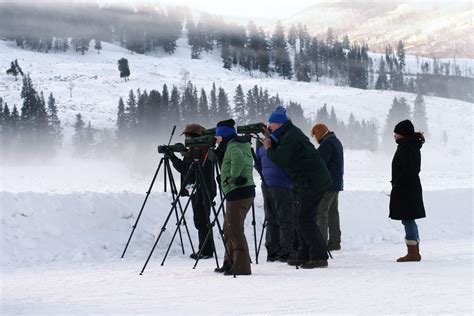Winter Wildlife Watching: What Can I See and Where?
As the chill of winter sets in, nature takes on a whole new beauty that can be truly mesmerizing. From majestic mammals to incredible invertebrates, the winter season offers a wealth of opportunities for wildlife watching. Whether you’re an avid nature enthusiast or just looking for a new outdoor activity to enjoy, winter wildlife watching can be a rewarding and educational experience.
In this blog post, we’ll explore the diverse world of winter wildlife and where you can find them. We’ll take a closer look at the majestic mammals that roam the snowy landscapes, the avian wonders that fill the winter skies, and the fascinating invertebrates that thrive in the cold. We’ll also delve into the world of cold-weather critters, as well as the aquatic adventures that await those who are willing to venture out into the winter marine environment. And for those seeking hidden treasures, we’ll uncover some of the best winter wildlife hotspots to visit.
So, grab your binoculars and bundle up as we embark on a winter wildlife adventure!
Majestic Mammals: Spotting Winter Wildlife
As the winter season sets in, it brings about a unique opportunity to spot some of nature’s most majestic creatures in their natural habitat. From the graceful deer to the elusive fox, winter wildlife offers a chance to witness these majestic mammals as they adapt to the colder months.
One of the most iconic winter creatures is the American Bison, often seen roaming the snow-covered plains of the Midwest. These massive beasts, with their shaggy coats and impressive horns, are a sight to behold against the winter landscape. Their resilience in the face of harsh weather is a testament to the adaptability of mammals in the wild.
For those looking to spot smaller, more elusive winter wildlife, the wily coyote is a thrilling sight to behold. Known for its sly and cunning nature, the coyote is a master of survival in the winter months. Their striking howls echoing through the crisp winter air add an enchanting element to any outdoor adventure.
Winter is also the perfect time to catch a glimpse of the regal elk as they forage for food in the snowy wilderness. With their imposing antlers and graceful movements, these majestic mammals are a testament to the beauty and resilience of nature in winter.
Winged Wonders: Avian Delights in Winter
Winter is a magical time for birdwatchers, as many avian species migrate to different areas in search of warmer climates and abundant food sources. This seasonal movement offers a unique opportunity to observe a diverse array of winged wonders in their natural habitats. Whether you are a seasoned birder or a newcomer to the world of birdwatching, the winter months provide endless opportunities to witness a spectacular display of feathered creatures.
One of the most thrilling aspects of birdwatching in winter is the chance to see rare and elusive species that are not usually present during other times of the year. From majestic raptors like bald eagles soaring through the sky to colorful songbirds such as blue jays and cardinals flitting among the snow-covered branches, there is no shortage of breathtaking sights to behold. Whether you venture into the heart of a sprawling forest or simply observe from your own backyard, the winter season offers a wealth of opportunities to discover new and exciting avian delights.
Another reason why winter is an ideal time for birdwatching is the enhanced visibility and clarity that comes with the stark, bare landscapes. With the trees stripped of their leaves and the ground blanketed in snow, birdwatchers have an unobstructed view of their feathered subjects. This makes it easier to spot and identify different species, as well as observe their unique behaviors and interactions. Additionally, the quiet stillness of winter provides a peaceful backdrop for birdwatching, allowing enthusiasts to fully immerse themselves in the sights and sounds of the avian world.
As you embark on your winter birdwatching adventures, be sure to arm yourself with a pair of binoculars, a field guide, and a sense of curiosity and wonder. Whether you encounter a flock of migrating waterfowl on a frozen pond or catch a glimpse of a cozy bird nest nestled in the boughs of a frost-covered tree, each moment spent in the company of winged wonders is sure to be filled with joy and amazement. So bundle up, venture outdoors, and prepare to be captivated by the avian delights that await you this winter.
Incredible Invertebrates: Finding Winter Bugs
Winter may seem like a quiet time for the insect world, but there are still plenty of incredible invertebrates to be found if you know where to look. Despite the chilly temperatures, many bugs are still active in the winter months, making it a great time to go on a bug hunt.
One of the best places to search for winter bugs is in rotting logs and leaf litter. These damp and decaying environments provide the perfect habitat for a wide variety of invertebrates, from beetles and centipedes to woodlice and earthworms.
Another great strategy for finding winter bugs is to look around outdoor lights at night. Many insects are drawn to artificial light sources, so taking a walk in the evening with a flashlight can reveal a whole world of fascinating creatures.
Don’t be deterred by the cold weather – with a little patience and some careful searching, you can discover a whole host of incredible invertebrates that are thriving even in the midst of winter.
Cold-weather Critters: Reptiles and Amphibians
When the winter months roll around, many people assume that wildlife goes into hibernation or migrates to warmer climates. However, reptiles and amphibians are a fascinating group of animals that have adapted to thrive in colder temperatures. From the slimy salamanders to the cold-blooded turtles, there are plenty of cold-weather critters to discover during the winter season.
One of the most intriguing aspects of reptiles and amphibians in winter is their ability to survive in freezing temperatures. Some species, like the wood frog, can actually freeze solid and then thaw out once spring arrives. The northern water snake, on the other hand, is known for its ability to survive in icy waters, making it a true winter warrior.
Exploring natural habitats and wetland areas is a great way to spot these cold-weather critters in action. Hiking through marshy areas or along riverbanks may lead to encounters with turtles basking in the sun, or snakes slithering through the underbrush. Observing these animals in their natural environment can offer a new perspective on how reptiles and amphibians adapt to the challenges of winter.
So, the next time you venture into the great outdoors during the winter months, keep an eye out for the incredible cold-weather critters that call these environments home. Whether it’s a colorful frog or a sunbathing turtle, reptiles and amphibians are proving that they are not afraid of a little winter chill.
Aquatic Adventures: Exploring Winter Marine Life
Winter may not seem like the ideal time to explore marine life, but there is actually a lot to discover beneath the icy waters. The marine life in winter is just as diverse and fascinating as in any other season, and by braving the cold, adventurous souls can witness some truly unique sights.
One of the most exciting things about exploring winter marine life is the chance to see different species that are not usually visible during warmer months. For example, some marine creatures migrate to colder waters during the winter, and this creates an opportunity for marine enthusiasts to spot them in their new habitats.
Additionally, the winter months can bring about changes in behavior and feeding patterns for many marine animals. This provides an opportunity to observe new and interesting behaviors that are not typically seen during other times of the year.
Ultimately, exploring winter marine life can be an incredibly rewarding experience for those who are willing to brave the cold. With the right preparation and mindset, a winter aquatic adventure can lead to unforgettable encounters with some of the most fascinating creatures on the planet.
Hidden Treasures: Discovering Winter Wildlife Hotspots
Winter may seem like a quiet time for wildlife, but there are actually many hidden treasures to discover if you know where to look. From elusive mammals to rare birds, the winter season offers a unique opportunity to spot these wildlife hotspots in their natural habitats.
One of the best ways to discover winter wildlife hotspots is by exploring local parks and nature reserves. These protected areas provide essential habitat for a wide range of species, and many offer guided wildlife tours during the winter months.
For those who prefer a more independent adventure, exploring lesser-known areas such as wetlands, forests, and meadows can also lead to exciting wildlife encounters. By venturing off the beaten path, you may stumble upon hidden gems where animals gather to forage and rest during the winter.
As the temperatures drop and the landscape transforms, it’s important to remember that wildlife still have their own routines and behaviors. By respecting their space and observing from a distance, we can ensure that these wildlife hotspots remain safe havens for the creatures that call them home.
Frequently Asked Questions
What types of mammals can be seen during winter wildlife watching?
Some common mammals to spot during winter wildlife watching include deer, foxes, hares, and squirrels. If you’re lucky, you may even catch a glimpse of larger mammals such as moose or elk.
Where are some popular winter wildlife hotspots for viewing avian species?
Popular winter wildlife hotspots for avian species include bird sanctuaries, wetlands, and nature reserves. These areas provide crucial habitats for wintering birds and offer excellent opportunities for birdwatching.
What types of insects and bugs can be found during winter wildlife watching?
In winter, insects and bugs become less active, but you can still find some species such as beetles, spiders, and certain types of caterpillars. Look for them in crevices, under bark, or in leaf litter.
Are reptiles and amphibians active during winter and where can they be observed?
Reptiles and amphibians are generally less active during winter, but in milder climates, they can still be found in suitable habitats near water sources. Look for them in areas with dense vegetation and near ponds or creeks.
Where are some great locations for observing winter marine life?
Coastal areas and marine sanctuaries are great locations to observe winter marine life. Look for tide pools, rocky shores, and areas with abundant kelp forests for the best chances of spotting diverse marine wildlife.
What are some lesser-known winter wildlife hotspots worth exploring?
Some lesser-known winter wildlife hotspots include urban parks, botanical gardens, and nature trails. These areas provide surprising opportunities to discover a variety of winter wildlife in unexpected urban and suburban settings.
How can I prepare for winter wildlife watching to make the most of my experience?
To make the most of your winter wildlife watching experience, make sure to dress warmly, bring binoculars and a camera, research the best viewing times and locations, and consider joining guided wildlife tours or events led by knowledgeable naturalists.






